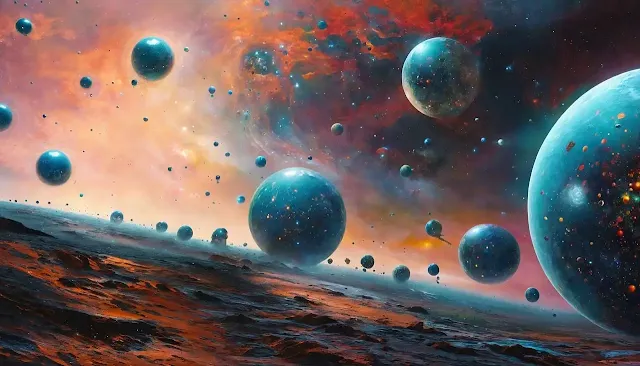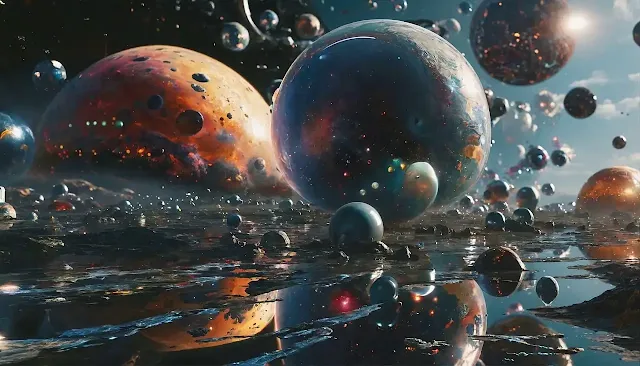What is the Braneworld Hypothesis?
Hey there! So, you've heard about the Braneworld? Pretty mind-blowing stuff, if you ask me! Well, buckle up because we're about to take a journey into the cosmos and dive into this mind-bending concept.
Now picture this:
You're standing on the edge of the universe, peering out into the vast expanse of space. But what if I told you that our universe isn't the only game in town? That's where the Braneworld Hypothesis comes in. It's like opening a door to a whole new dimension.
Imagine our universe as a slice of bread in a cosmic sandwich, with other slices (or "branes") floating out there in the multiverse. These branes aren't just parallel universes; they're entire universes with their own laws of physics and maybe even their own versions of you and me.
But how did we stumble upon this mind-bending idea? Well, it all started with a bunch of brilliant minds grappling with the mysteries of the universe. They dared to ask the big questions and, in doing so, stumbled upon the mind-blowing concept of braneworlds.
Alright, let's set the stage for this mind-bending adventure into the Braneworld Hypothesis. Imagine a time when physicists were scratching their heads, pondering the mysteries of the cosmos. They had Einstein's theory of general relativity in one hand and quantum mechanics in the other, but something just wasn't adding up.
You see, these two pillars of modern physics didn't quite see eye to eye. General relativity described the universe on a large scale, while quantum mechanics delved into the weird and wonderful world of the very small. It was like trying to fit a square peg into a round hole.
But then, in the late 20th century, along came some brilliant minds with a crazy idea: what if there were more dimensions to the universe than we could see? What if our universe was just one slice of a much larger cosmic pie?
And thus, the Braneworld Hypothesis was born. It proposed that our universe, or "brane," was just one of many floating in a higher-dimensional space. Suddenly, the universe didn't seem so cramped anymore. There was room for all sorts of weird and wonderful possibilities.
But don't think for a second that this idea was accepted with open arms. Oh no, it sparked fierce debates and heated discussions among physicists. Some embraced it as a revolutionary new way of thinking about the cosmos, while others dismissed it as pure science fiction.
And yet, despite the skeptics and the naysayers, the Braneworld Hypothesis continued to captivate the imaginations of scientists and laypeople alike. It offered a tantalizing glimpse into a universe that was stranger and more wondrous than we could have ever imagined.
So, strap yourselves in and get ready to delve deeper into the mysteries of the Braneworld Hypothesis. Who knows what cosmic secrets we'll uncover along the way?
Fast forward to the late 20th century, when the Braneworld Hypothesis began to gain traction among physicists. Inspired by developments in string theory and M-theory, which hinted at the existence of extra dimensions beyond the familiar three spatial dimensions and one time dimension, scientists started to seriously entertain the idea of braneworlds.
The concept of braneworlds provided a fresh perspective on some of the most perplexing questions in cosmology. Suddenly, phenomena like dark matter, dark energy, and the Big Bang could be reexamined through the lens of multiple branes interacting within a higher-dimensional space.
As research progressed, physicists began to explore the mathematical underpinnings of the Braneworld Hypothesis. They developed sophisticated models that described how our universe could be embedded within a larger multidimensional framework, where gravitational forces could extend beyond our brane and interact with others.
But the Braneworld Hypothesis wasn't just a mathematical curiosity; it also offered testable predictions that could potentially be observed through astronomical observations and experiments. From the behavior of gravitational waves to the distribution of matter in the universe, researchers began to search for signs that could support or refute the existence of braneworlds.
Of course, like any bold new idea in science, the Braneworld Hypothesis wasn't without its skeptics. Critics raised valid concerns about the complexity of the models, the lack of direct experimental evidence, and the potential for alternative explanations. Nevertheless, proponents of the theory pressed on, driven by the tantalizing possibility of unlocking the secrets of the universe.
And so, the Braneworld Hypothesis continues to be a vibrant area of research in theoretical physics, inspiring new generations of scientists to push the boundaries of our understanding. Who knows what other marvels of the cosmos await us as we journey further down the rabbit hole of braneworlds? Strap in, because the adventure is just beginning.
Key Concepts of Braneworld Hypothesis
Alright, let's dive into the heart of the matter and unpack the key concepts of the Braneworld Hypothesis. Don't worry, we'll take it nice and slow, step by step.
Extra Dimensions: Picture our familiar three spatial dimensions—length, width, and height. Now, imagine that there are additional dimensions beyond these, hidden from plain sight. These extra dimensions are where the magic of the Braneworld Hypothesis unfolds.
Brane: Short for "membrane," a brane is like a slice of the universe, a cosmic pancake if you will. Our universe, including all matter and energy within it, is thought to be confined to a brane embedded within a higher-dimensional space.
Multiverse: Brace yourself for this one. The multiverse isn't just a sci-fi trope; it's a fundamental aspect of the Braneworld Hypothesis. Imagine a cosmic buffet of branes, each representing a separate universe with its own laws of physics and perhaps even its own version of you reading this article.
Gravity: Now, let's talk about everyone's favorite force: gravity. According to the Braneworld Hypothesis, gravity isn't confined to our brane but can leak into the extra dimensions. This has profound implications for how gravity behaves on both small and large scales.
String Hypothesis: Ah, the darling of theoretical physics. String theory provides the theoretical framework for the Braneworld Hypothesis, suggesting that fundamental particles are actually tiny strings vibrating in higher-dimensional space. It's like a symphony of cosmic harmonics.
Cosmic Inflation: Ever wonder how the universe went from a tiny speck to the vast cosmos we see today? Enter cosmic inflation, a period of rapid expansion thought to have occurred shortly after the Big Bang. In the context of the Braneworld Hypothesis, inflation may be driven by interactions between branes.
Experimental Signatures: Last but not least, let's talk about how we can put the Braneworld Hypothesis to the test. From observations of the cosmic microwave background radiation to experiments at particle accelerators, scientists are on the hunt for experimental signatures that could support—or challenge—this radical new framework.
Implications of Braneworld Hypothesis:
Alright, let's fasten our seatbelts and explore the mind-bending implications of the Braneworld Hypothesis. Get ready, because things are about to get cosmic!
Multiverse Mania: First things first, the Braneworld Hypothesis opens the door to a vast multiverse of possibilities. Picture an infinite cosmic tapestry, with each brane representing a separate universe with its own unique properties. Suddenly, the universe feels a whole lot bigger—and weirder—than we ever imagined.
Parallel Worlds: Ever wonder what your life would be like in a parallel universe? Well, thanks to the Braneworld Hypothesis, you can let your imagination run wild. From mirror images of Earth to realms where the laws of physics are completely alien, the multiverse is a playground for the imagination.
Gravity Gone Wild: Brace yourself, because gravity is about to get a whole lot crazier. In the context of the Braneworld Hypothesis, gravity isn't confined to our brane but can leak into the extra dimensions. This opens up tantalizing possibilities for new phenomena, from exotic gravitational waves to strange gravitational interactions between branes.
Cosmic Connections: Remember those pesky dark matter and dark energy puzzles? Well, the Braneworld Hypothesis might just hold the key to unlocking their secrets. By reimagining the cosmos as a network of interconnected branes, scientists can explore new explanations for these mysterious cosmic phenomena.
Birth of the Universe: How did the universe begin? It's the ultimate question, and the Braneworld Hypothesis offers a fresh perspective. According to some models, our universe may have been born from the collision of branes in a higher-dimensional space—a cosmic cataclysm that set the stage for the emergence of galaxies, stars, and planets.
Fate of the Universe: Finally, let's ponder the fate of the universe itself. In a multiverse teeming with branes, each with its own destiny, the possibilities are endless. From eternal expansion to cosmic collapse, the Braneworld Hypothesis invites us to contemplate the ultimate fate of our universe—and what lies beyond.
Challenges and Debates:
Alright, let's roll up our sleeves and wade into the murky waters of the challenges and debates surrounding the Braneworld Hypothesis. Spoiler alert: things are about to get heated!
Occam's Razor: One of the biggest criticisms leveled against the Braneworld Hypothesis is its sheer complexity. Critics argue that it violates the principle of Occam's Razor, which states that the simplest explanation is usually the best. With its multiverse of branes and extra dimensions, the Braneworld Hypothesis might just be guilty of overcomplicating things.
Experimental Evidence: Another thorn in the side of the Braneworld Hypothesis is the lack of direct experimental evidence. While the hypothesis makes some tantalizing predictions that could potentially be observed through astronomical observations and experiments, none have been definitively confirmed. Until we have solid experimental evidence to back it up, skeptics will continue to cast doubt on the validity of the hypothesis.
String Hypothesis Snags: Let's not forget that the Braneworld Hypothesis is intimately connected to string theory, that darling of theoretical physics. But here's the thing: string theory itself is far from being a proven scientific fact. Critics argue that basing a theory on such shaky theoretical foundations is like building a house on sand—it's bound to collapse under scrutiny.
Alternative Explanations: Finally, let's consider the possibility that there may be alternative explanations for the phenomena that the Braneworld Hypothesis seeks to explain. From modified theories of gravity to entirely new frameworks for understanding the cosmos, there's no shortage of competing ideas vying for attention in the crowded marketplace of theoretical physics.
But hey, let's not throw the baby out with the bathwater. Despite these challenges and debates, the Braneworld Hypothesis continues to captivate the imaginations of scientists and laypeople alike. After all, what's science without a healthy dose of skepticism and debate? So, let's keep asking the big questions and pushing the boundaries of our understanding. Who knows what cosmic mysteries we'll uncover along the way?


